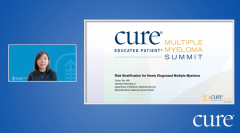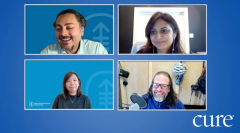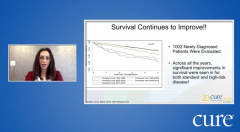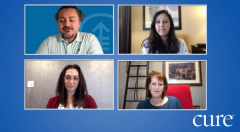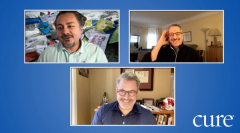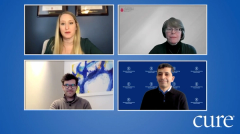
Educated Patient® Multiple Myeloma Summit Basics of Myeloma Panel: March 12, 2022
Watch Saad Z. Usmani, MD, MBA, with Carlyn Rose Tan, MD; Neha S. Korde, MD; and Kenny Capps answer audience Q&A during the CURE Educated Patient Multiple Myeloma Summit.
This panel featured Saad Z. Usmani, MD, MBA, with Carlyn Rose Tan, MD; Neha S. Korde, MD; and Kenny Capps from Throwing Bones.
Usmani: My first question here is for Dr. Korde. Should first-degree relatives be tested for MGUS?
Korde: Right, that's a great question. I think, you know, at this point, we don't have any definitive evidence that they should be tested. The thinking behind that is that, you know, as we're still sort of sorting out, who's that risk, which patients are at risk for progressing, I think one of the things that we need to understand is, is which interventions are appropriate. So even for those patient populations, like family history, or patients that have, you know, a certain, you know, ethnic or racial description. So for Black patients should they be screened? These are all questions that we're currently answering right now in the field. I think when we look at that Icelandic study, that'll give us some clue as to, you know, because the way that that clinical trial is designed, they're actually looking at different follow up mechanisms. And also with the smoldering patients, those patients have certain treatment options. But that will probably be the biggest, you know, test right now as to what to do with screening. Once we figure that part out, I think, then we're probably going to go back into some of these more high-risk subpopulations, and then, you know, come up with some better clinical guidance, this point.
Usmani: Thank you, Dr. Korde, I think you've summarized things very, very nicely. One thing that I wanted to just, you know, put in as a comment, you know, in reference to this question, when we talk about screening and doing, you know, screening studies, they have to be done in a geographically defined area. I think, that's the big strength of what was done in the Olmstead County, in Rochester, Minnesota. That's the strength of what's been done in the eyes stop mm study. And, you know, my expectation would be as as we start generating this data we are really focusing on specific geographic areas. And, you know, and find the true incidence and prevalence of, you know, MGUS and precursor conditions in racial and ethnic populations living in a specific area. Alright, so the next question is for Kenny. So this is an open-ended question, Kenny. And I know you're very passionate about this topic. So how does a healthy lifestyle play a role in a myeloma diagnosis?
Capps: Thank you. Well, yes, you're right. I am pretty passionate about it, because I see the benefits of it. Not just for myself, but for other people. And also, I think, and I can't speak for you as health care professionals, but I think that you see the benefits of it in trying to treat your patients if they're in an optimal, you know, healthy condition. For one thing, if they're unable to go through some of the treatment that's available to them because they're otherwise battling other comorbidities for lack of a better word, such as hypertension, high blood pressure, pre-diabetes, diabetes, maybe forms of obesity, but if they're otherwise unable to take some of the treatment that you're setting up for them, In order to put them in their best position to have their best quality of life, or maybe even length of life, then they're at a disadvantage. So I think the first one is to put themselves in the best position possible. Also, it's part of living. And one of the things that I try to remind myeloma patients, when they've reached out to me, just to sort of walk them through what their journey is, like right now is to is that they need to focus on they should focus on living with this disease, as opposed to worrying about dying from this disease so much, because that's a big chunk of it. And it's a slight change of perspective, but it's a major change of perspective, also, focusing on the living aspect. And that means moving, that means continuing to do things. And there are things that they can do. And I think they often they misinterpret what it is that you're telling them as their health care provider, and that I'm dealing with this thing, I either have bone involvement, or I'm otherwise having some GI issues or etc, etc. And so they take that as a reason, maybe even an excuse to not do anything, which of course, only exacerbates what they're going through with makes things much worse. And then at that point, they started to forget to live.
Usmani: That is an apt, and typical Kenny answer, I love it. And you're such a, you know, role model for other myeloma patients to follow. So thank you for what you do, you know, and for your advocacy in making this point. Alright, Dr. Tan, I have a question for you. So does it matter what percentage of cells have a specific chromosome abnormality? For example, if a patient you know, on their bone marrow has 6% deletion 17p versus 40%?. Does that matter?
Tan: I think the patients who have deletion 17p overall, still would be considered as high risk, regardless of the percentage. It doesn't make me concern the patients with 40% may progress faster, but both are still considered high risk features.
Usmani: Yeah, I would agree with that. I think there is some data from, you know, the French myeloma group looking at, you know, the percentage of deletion 17p cells and CD-138 enriched. Specimen. I think, you know, one of the things that our friends colleagues, or, you know, Professor Avi Lewis, started to highlight is, you know, we need to do, you know, cell enrichment before we do the FISH, and get a realist, or kind of realistic picture of the percentage of cells relevant to the myeloma cells, rather than the whole bone marrow aspirate. So, you know, so there's some truth to that. And I agree with you, I think, you know, we do worry about patients with presenting with a higher proportion of a specific high-risk feature like deletion 17p. But if you have it, you have it. And that's the other important piece, because sometimes we're not getting, you know, the bone marrow aspirate of good quality from, you know, from a patient because of technical reasons. So if, if you have it and it fits the clinical picture, I think we have to take it on face value, and it's real. All right. Would you agree with that Dr. Tan?
Tan: I agree. 100%.
Usmani: Next question is for Dr. Korde. I have been diagnosed with a solitary plasmacytoma. Is this considered myeloma MGUS or smoldering? Is it its own category?
Korde: Yeah, that's a great question. For solitary plasmacytoma, as we categorize them, if they're from emanating from the phones, so it's it so to answer the question, it's its own clinical distinct category. However, it fits into this whole plasma cell spectrum, you know, as we're going from low disease burden all the way to high disease burden. It's sort of an offshoot onto its own category, but biologically, it's the same, what we're saying is, is that, you know, you have these clonal plasma cells and they're affecting either your bone or they can also be affecting a particular extramedullary space, like an organ, for instance. So plasmacytoma has are categorized either emanating from the bone or they're, they're outside of the bone tissue, which means that they're extramodularity. So, you know, it fits in this whole plasma cells spectrum, but it is sort of, you know, put off to the side a little bit between smoldering myeloma, you know, clearly we're saying that there is some sort of organ damage there that these coronal plasma cells are, are causing this. So it's behaving in a malignant manner.
Usmani: Spot on Dr. Korde. Alright, Kenny, I have a question for you. Why is it important to be a patient advocate? And, you know, what would your advice be about collaborating with the caregiver team?
Capps: Yeah, I've actually been asked that question a lot. Because I strongly I talk about it a lot. But I also recognize that it's, it's hard sometimes, walking in, especially right close to your initial diagnosis, it's tough as the patient to absorb the information that you're receiving, especially since it's probably all new, you've never heard a lot of these diseases. And considering how quickly even my home research is going right now. You have to stay on top of it. Y'all are the experts. And I'm sure that even you get lost in the mix. I've been to ASH, I know how overwhelming this information is. So think about it coming from somebody who's never even heard of multiple myeloma before comes in and has to process not only the fact that they have a cancer, a blood cancer now, but what does that mean? And what is it they need to do next. And so I think that initially, you need to go in and have this, have somebody to help you assist you, if nothing else, just to be there and how to process the information and receive it. And, but the reason why it's so important and why it's so valuable is not just so they know, but also so that they can give their health care providers, their team, as it were, it should be a team, because I've got a lot of opinions on internet collaboration amongst healthcare professionals is they need to be able to give that feedback that you're looking for. Because if they just take the information that you've given them, or the maybe the recommendations or suggestions for treatment, and just do that, it's hard for you to know whether you're heading in the right direction or not, there's so many variables that you don't know unless you get feedback, and not all of its gonna come from a FISH test or from a myeloma panel, some of that has to come from the individual. And so in order to do that, they're gonna have to speak up, they're gonna have to speak up, and they're the only ones who actually can live inside their own body in order to do that.
Usmani: I'm now in remission from solitary plasmacytoma for over 10 years. Is there still a probability that I might develop myeloma over the next several years?
Korde: You know, a lot of the solitary plasmacytoma literature – and if any of the panel members can jump in and help me out on this question – when they did the original follow-up studies, it was really at the 10-year mark, but I think you know, whether or not somebody goes on to developing multiple myeloma or solitary plasmacytoma. I think the idea though, is that once you have this login process, and you have this plasmacytoma whether it's, you know, after the 10-year mark, the 15-year mark, 20-year mark, I think you should always still undergo surveillance. It's hard to say that somebody is still cured just beyond 10 years if you don't have a second plasmacytoma pop up, I think still undergoing those scans or whatever your treatment plan is, that's recommended by your doctors and it’s still important. And, you know, hopefully it remains that way. But I think, you know, these plasmacytomas, they can remain indolent in a person's body, we know this from MGUS/smoldering studies that they can remain, you know, pretty indolent for several years, even up to 20 years, and then pop up, you know, later on. So, I tend to always want to think the best-case scenario, but to remain vigilant, still, even beyond 10 years, is what my gut clinical instinct is telling me.
Usmani: I think that's very appropriate. These may have the likelihood of, you know, getting into trouble is low, but it's still there. So, you know, I think this is where, you know, it becomes more of an art than science, as a treating physician. We would still like to maintain some level of vigilance, just to make sure that you don't get into trouble. So it would be a reasonable thing to follow your myeloma doc or hematologist who's taking care of you for your condition, and just continue to have follow-up labs or imaging. And you're still a young person, you know, they may have, they mentioned their age, they're in their mid 50s. So I think, you know, they still have a ways to go. So, you know, don't let this become the center of everything that you do, but continue to follow up with your doc.
Okay, so Dr. Tan, does original staging still influence treatment? Or does it still apply after someone has had their initial therapy and now have relapsing disease? …So if you had deletion 17p or 1114 at the time of diagnosis, does it matter in terms of choices of treatment, when you relapse?
Tan: The short answer is yes. You know, the time where you respond to treatment is different if you had high-risk disease at diagnosis. And also when you develop relapsed disease, patients that have the translocation 1114 at diagnosis, you know, relapsed, we can use (Venclexta [venetoclax]). So it can still play a role throughout the disease course. As well as the stage.
Usmani: It's not as much as the ISS staging, but the chromosome abnormalities or, you know, presence or absence of extramedullary myeloma or maybe circulating plasma cells, you know, those kinds of things would, I guess, matter. You know, as we're thinking about picking and seeking treatment options.
Okay, so, so this question is actually for both Dr. Korde and Kenny. So Dr. Korde, you know, you mentioned the possibility of lifestyle modification for smoldering myeloma patients. So I know you were referring to one of our other MSK colleagues, you know, whose area of interest this is. So what are your thoughts around that? And then, once you've given your answer, maybe I can go to Kenny. So what about smoldering myeloma patients so these are patients who are not there yet in terms of getting treatment but you know, how can lifestyle modification actually help those patients?
Korde: I love this question. I think that we're gonna see a whole flurry of trials and being conducted along these lines to see exactly how lifestyle modifications are helping smoldering patients, MGUS patients in this precancer or premyeloma timeframe. I think right now, we don't necessarily have a definitive answer to that question of how one can you know, or what lifestyle modifications can benefit patients with smoldering or MGUS. But I think one of the things is that there's two aspects of it. One is that we're understanding that, you know, the immune system may be playing a huge role in terms of surveilling patients, or at least doing some sort of immuno surveillance where they may be actually benefiting a microenvironment for, you know, patients to remain in a smoldering state, and not necessarily progressing to multiple myeloma. So these are sort of the questions that are being answered by for instance, my colleague, Dr. Urvi, Shah of the Memorial Sloan Kettering, she's running a study, which is called the neutral vention study. And she's looking at, for instance, a plant based diet, and whether or not that is helping your immune system or altering your gut microbiota, to kind of help promote a micro environment that would really keep the state of smoldering and looking at different end points along those ways. But I think that they're beyond that, and I think this feeds probably into Kenny's answer is, is that there's also something to be said about, you know, what a lifestyle modification intervention plan may do for your mind, body and soul.
So as you're sort of leading into, okay, how am I dealing with this precursor disease state? And, you know, what is it? What are all the implications? You know, it means, I think, kind of creating this sort of healthy environment of exercise, healthy diet, and almost prepping your body. I have a lot of smoldering patients saying, you know, what, I know you're telling the doctor for day, I don't have multiple myeloma yet, but I want to be prepared for that fight. When you tell me I do. And what does that you know, you know, I want to have the, the best possible, you know, body prepped or mind prepped for me so once you tell me I need chemotherapy that that, you know, I'm going to take on this fight. So I think that, you know, with that, that might, you know, help, or, you know, launch into Kenny's answer. I'm curious to hear what he has to say about that.
Capps: Yeah, actually, that is a great question. And I really liked the direction you're going I so like the idea of the study that Dr. Shaw's doing. I didn't know about that the plant base, that's actually really excellent. So it's interesting, I actually just started working with a coaching client, someone who was diagnosed with high-risk smoldering in January. And of course, you know, now there's a recommendation, or at least that's one of the things on the table is encouraging treatment, when high-risk smoldering, and she had apparently had lived with MGUS and jumped into the high risk category for a couple of years into now this sort of scary ‘No Man's Land’ is where she's at. And she's just kind of not sure where to go. And so I would say one thing, it's an opportunity, sort of like what you were leading to, Doctor, what is it that there's, there's an opportunity here to create a lifestyle, maybe upgrade, and moving into a position of making that a part of your everyday core thing is what it is that you do, so that the treatment side of things potentially could be inconsequential, other than is really at least less disruptive, because you're already doing the things in order to just be part of living life. Whether that means, you know, regularly being active by going around the neighborhood and walking with purpose and in trying to improve yourself or losing weight or otherwise just feeling better.
But it also can be sort of a mindset shift in what it is that we're trying to focus on. Because I think very often we lose focus in or at least questions. Maybe we hyper focus on what the problem is, versus actually making a general solution, which is again, what our goals are, which is, you know, quality of life. I mean, it seems like it's overplayed, but it's true. It's focusing what our quality of life is. And so in a weird way, that MGUS/smoldering status is that it really can be viewed as an opportunity. And I think that it could be presented that way from someone who's diagnosing their patients that like when this is a chance, this is a chance for you to actually set yourself up for success. I don't remember and maybe you can remind me what's the percentage of progression from MGUS or smoldering to the next level? What is that per year now? Do you have been off the top your head?
Korde: So for smoldering, it's 10% per year for the first five years. And then MGUS, it's around 0.5% to 1% annual risk.
Capps: Right. So I mean, so when you're not already in that high-risk smoldering state, which of course we now have, the scene is you have a much higher chance of progressing substantially higher chance but when you're in those lower states, of course, it's an opportunity to improve it's an opportunity to live it's an opportunity to see the world maybe in a different light and through different eyes. So it doesn't have to be all gloom and doom and we don't have to use that as not as sort or experience that as No Man's Land as that. When is that going to happen? When is the axe gonna fall? And we don't have to live under that fear so much. If we look at it again as motivation to do things we should have been doing anyways. That's my take.
Raw transcriptions have been lightly edited for clarity.
For more news on cancer updates, research and education, don’t forget to

